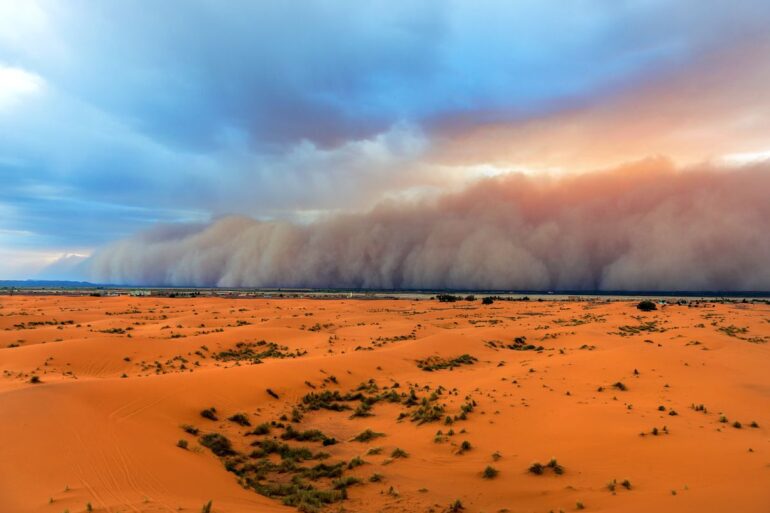TL;DR:
- Dust storms, natural phenomena driven by strong winds, carry fine particles into the atmosphere, impacting various sectors.
- Study examines Alaskan dust’s role in climate, focusing on Copper River Valley as a source.
- Dust storms influence climate by affecting cloud formation and ice nucleation.
- Clouds, formed around particles like dust, have significant energy balance effects.
- Alaskan dust differs from Saharan dust in composition, particle size, and ice nucleation.
- Alaskan dust’s unique properties contribute to cloud and ice formation.
- Despite minimal global dust emissions, Alaskan dust can influence INP budget substantially.
- Study highlights the need for further research on high-latitude dust sources.
- Insights improve climate understanding, aiding predictions and responses.
Main AI News:
In the intricate web of Earth’s climate system, natural occurrences like dust storms wield a profound influence. These storms emerge when forceful winds uplift copious amounts of fine particles from parched and desolate terrains into the atmosphere. The ramifications of such phenomena encompass diverse realms, spanning environmental facets, human well-being, agricultural enterprises, and transportation networks. Yet, how do these storms reverberate through the global climate mechanism? A pioneering exploration conducted by experts hailing from the esteemed University of Leeds and the esteemed National Center for Atmospheric Science delves into this enigma. Their scrutiny is directed at an exceptional source of dust nestled in high latitudes: the Copper River Valley of Alaska.
Deciphering the Nexus: Dust Storms and Climate Dynamics
At the crux of the intricate dance between dust storms and climate dynamics lies their impact on cloud formation and ice nucleation. The tapestry of clouds is woven from minuscule water droplets or ice crystals coalescing around airborne particles – these could range from dust and pollen to smoke and pollution. These constituents are christened cloud condensation nuclei (CCN) or ice nucleating particles (INP), based on their predilection to foster either the liquid or ice phase within clouds. Clouds, in their myriad forms, play a pivotal role in modulating the planet’s energy equilibrium. They counteract the influx of solar radiation by reflecting a portion back to space, thereby exerting a cooling influence. Conversely, they ensnare some of the outbound infrared radiation from the Earth’s surface, yielding a warming effect. The climatic impact of clouds is contingent upon their type, location, altitude, and composition.
Pertinacious Pursuit: Unveiling Alaskan Dust’s Unique Traits
Dust storms possess the capability to amplify the diversity and quantity of CCN and INP within the atmosphere, thereby molding the attributes and demeanor of clouds. Notably, dust particles can amplify the crystallization of ice within sub-freezing clouds, a phenomenon with cascading effects on cloud longevity, precipitation, and radiative dynamics. Nonetheless, the prowess of dust particles in nucleating ice is far from uniform. Previous inquiries have predominantly scrutinized dust from desert terrains like the Sahara, nestled in mid to low latitudes. The freshest chapter of scientific inquiry, chronicled within the annals of Science Advances, pivots towards a high-latitude originator of dust – the Copper River Valley in Alaska.
Divergence and Consequence: Alaskan Dust’s Discernible Disparities
The Copper River Valley emerges as a critical fount of glacial detritus, transported by the coursing river and deposited in its delta. When water flow recedes, as witnessed during the summer and autumn, potent gusts of wind seize the opportunity to hoist significant quantities of this sediment aloft. These aerial plumes of dust, observable even from the expanse of space, embark on journeys spanning hundreds to thousands of kilometers, traversing the North American terrain. The researchers harnessed remotely operated vehicles (ROVs), maneuvered with precision by the Hawai’i Undersea Research Laboratory (HURL) to procure samples of this airborne sediment. These samples underwent meticulous assessment of their physical and chemical attributes, alongside their ice nucleation propensity, through laboratory simulations. Satellite data lent insight into the frequency and extent of dust episodes in the vicinity.
Cognizant of Diversity: Alaskan Dust’s Intriguing Attributes
The Alaskan dust, in contrast to its Saharan counterpart, boasts distinctive facets. Foremost, Alaskan dust showcases an augmented quotient of organic constituents, encompassing fragments of vegetation and microorganisms. These elements potentially steer its interplay with water and ice. Secondly, the composition of Alaskan dust tilts towards a greater fraction of coarse particles, each exceeding 10 micrometers. This compositional nuance is primed to exert a sway on its dispersal and sedimentation patterns. Thirdly, Alaskan dust outperforms its Saharan kin in terms of ice nucleation efficiency, particularly within the temperature range spanning -15°C to -25°C – a spectrum germane to mixed-phase clouds.
Amplified Impact: Alaskan Dust’s Resonance in the Climate Nexus
The import of these dissimilarities resonates within the expanse of the climate system. Startlingly, Alaskan dust, while constituting a mere 2% of the planet’s dust emissions, possesses the potential to furnish up to 20% of the worldwide INP allotment in temperatures corresponding to its superior ice nucleation ability. This unexpected potency endows Alaskan dust with the capacity to orchestrate substantial modifications in cloud formation and ice nucleation over expansive tracts of North America and beyond. This study unearths fresh perspectives into the intricate interactions between high-latitude dust sources and the global climate apparatus. Additionally, it underscores the exigency of further exploration concerning wind patterns, precipitation regimes, and the overarching specter of climate evolution, as determinants shaping dust emission and dissemination from these zones.
Conclusion:
This research sheds light on how unique high-latitude dust sources influence climate dynamics. The distinct attributes of Alaskan dust, its amplified ice nucleation capacity, and its potential to affect cloud formation could drive innovations in climate monitoring, renewable energy, and agricultural sectors. Understanding these dynamics equips businesses to navigate and harness opportunities arising from evolving climate patterns.

